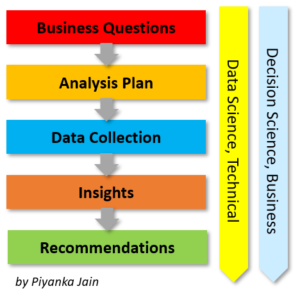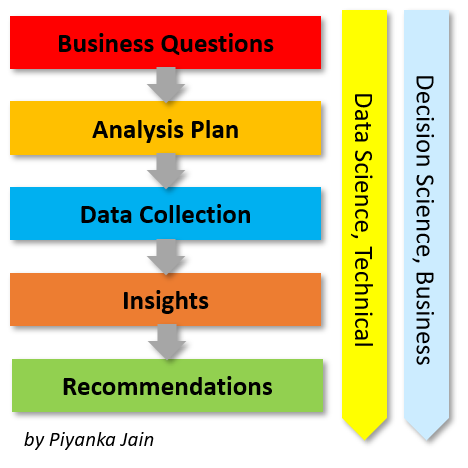This article is aimed to share the BADIR approach by Piyanka Jain, who is running a data science consulting company in the state. My data analytic career was started the SAS Institute consulting team and I was applying Six Sigma – DMAIC approach for projects. After studying this approach by Piyanka, my project team is taking this implementation method for all professional services in Data Science.
5 steps – BADIR Approach
This proprietary Data-to-Decisions framework is being widely used in organizations. There are 5 different major steps:
- Business Questions – identify the business pain points
- Analysis Plan – plan and models are selected with other preparations like data gap analysis
- Data Collection – collect data necessary for the analytics planned
- Insights – discover insights from step 1 to 3.
- Recommendations – provides suggestions / recommendations to the management

Step 1: Business Questions
In order to help identify the business pain and problem, we start with asking questions like:
What
Who
Where
When
Why and
How
Thus, you have to understand what you are trying to solve. It is suggested to define a problem by taking root cause analysis. Once you know Why, then ask other questions for understanding the scope of the problem.
Step 2: Analysis Plan
Now that you have the problem def Business problems can be large in scope for implementation so narrowing the objectives or breaking it into parts to make sure goals are manageable. Perhaps the most popular of all analytical models is SWOT – Strengths Weaknesses Opportunities and Threats. There are lots of activities involved like data profiling to have a prelim understanding on data and to identify any missing pieces in the source data. With the problem(s) located in step 1, the statistical or data model are related to the nature of the problems. To take an example, you would like to have a full understanding of customer and likely a clustering of customer is a must-do task.
Finally, the analysis model and implementation plan will be concluded in this phase. However, future refinement on the plan will be possible during the step 3 and 4 later.
Step 3: Data Collection
In order to answer the business problem(s), it is needed to collect relevant information (data) within the organizations from different systems or outside the organization such as open data in the market or from government bodies. It is possible to require research using other analytical models such as STEEP – Social Technology Economics Environment Political.
For the data collection, it is not just related to the variety and volume of data. There is another difficult and time-consuming task – data cleansing for maintaining the data quality. For most data scientist (including myself), I have spent 60-70% of time in the preparation of data before any analysis.
Step 4: Insights
At this stage, intelligent information will be presented to stakeholders or managers for insights discovered during the analysis (both descriptive and predictive). The planned analytic model(s) in step 2 will be applied by injecting data from step 3. Next, it helps validate patterns in the data if there is a real problem and if there are unusual patterns in key variables. Then, additional testing will be applied to prove or disprove hypotheses. Finally, the findings tested will be presented to the corresponding parties. Moreover, it is important to make sure the flow and underlying processes on the insight discovery.
Step 5: Recommendations
For the recommendation stage, it is the final step for addressing any issue. However, this may be the most important step as it is required to take action for positive impact. The main purpose of the process is to turn data into insights and then insights into actions. High level recommendations will be presented to the top managers and values should be demonstrated throughout the presentation.
Summary
Personally, I think it is an approach easy to understand and follow. For this article, it is just an overview on BADIR approach. It is suggested to read the book written by Piyanka Jain – “Behind Every Good Decision: How Anyone Can Use Business Analytics to Turn Data into Profitable Insight” (ISBN-10: 0814449212). Also, further information is also available in the website for the consulting company running by Piyanka Jain.
http://www.aryng.com/aryng_BADIR_advantage
Samuel Sum
Data Science Evangelist (CDS, SDi)
Vice President (AS)

